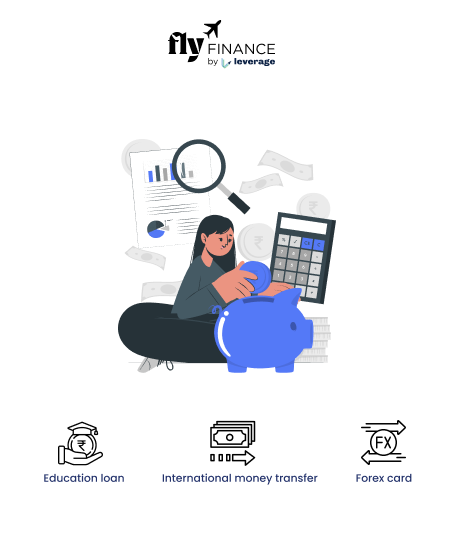How to Self-Finance Your Study Abroad Dream: Studying abroad is a dream for many Indian students. It opens doors to global opportunities, top-notch education, and exciting career prospects. But let’s face it—financing this dream can feel overwhelming. Tuition fees, living costs, and travel expenses add up quickly. The good news? You can self-finance your study abroad journey with smart planning and determination.
This guide shows you how to fund your international education without relying solely on loans or family support. Ready to turn your dream into reality? Let’s dive in!
This Blog Includes:
What is Self-Funding?
Self-Financing is when you take an education loan from a bank, you need to repay the loan amount back with interest after you’re done completing your studies. This might prove extremely challenging for many students as they will be burdened by debt after completing their studies, something that many students prefer not to choose. This is the primary reason why many students and parents consider self-finance for overseas education. Here are a couple of self-finance options you need to keep in mind:
- Asking family members to provide financial help for your studies
- Financing your own tuition fees
- Choosing a loan from a third-party source
Also Read: What is SWIFT Wire Transfer?
How Can You Budget Your Education While Self-Funding?
If you have plans to self-finance your education expenses, you might not have much room to incur extra savings and expenses. Hence, you need to make sure you’re coming up with the proper methods so that you can budget your education expenses while also taking help from the appropriate sources. Here are some helpful sources you can consider.
Financial Plan
You need to plan out your budget as well as calculate the expenses before you choose your study abroad destination. This is one of the most effective things you need to keep in mind. You also need to arrange a sufficient amount of funds so that you can be prepared for any unexpected financial difficulties, which you might face during your stay and study abroad.
Scholarships
Scholarships are undoubtedly extremely effective at helping students pursue their study abroad dream. If you manage to bag a scholarship, you won’t face any problems financing your tuition fees.
But keep in mind that the scholarships for international students will vary according to your merit and other factors. For instance, some scholarships only cover the tuition fees whereas, others cover the tuition fees, accommodation expenses, and travel expenses.
Also Read: Common International Money Transfer Terms
Part-Time Work
This is also another effective way to self-finance your study abroad experience. Depending on the country as well as the university you’re choosing, part-time work will undoubtedly prove extremely beneficial for self-financing your study abroad expenses.
Education Loan for Study Abroad
If you have plans to complete your education abroad, you might want to choose a reputed university so that you can leverage the benefits of high-quality course materials. However, one thing you need to remember is that it’s undoubtedly an expensive affair. Using the entire life savings of your parents to self-finance the overseas expenses might prove a risky investment. This is why you need to pay close attention to the other sources of financial assistance.
When you take an education loan, you will be able to make sure that you have the necessary amount of money to pay for the accommodation expenses as well as the tuition fees. This way you will be able to reduce your headache while focusing more on your education.
Types of Education Loan
This is one of the most important points you need to remember about education loans. If you don’t know the availability of the different types of education loans, you will never be able to choose the perfect one as per your needs. Here are the different types of education loans you need to know.
Secured Loans
Secured loans are one of the most popular types of education loans you need to keep in mind. The secured loans will be provided by banks or other financial institutions on collateral. This specific loan is perfect for people who have proper assets to pledge security to the bank. Secured loans not only feature a higher loan amount but also a lower interest rate. The approval rate of the secured loans is also higher.
Unsecured Loans
People who don’t have collateral for secured loans should choose unsecured loans. Unsecured loans are another famous type of education loan that will help you obtain a specific amount of money without pledging anything to the bank. The interest rate of unsecured loans will always be higher than that of secured loans. On top of that, the acceptance rate of unsecured loans will depend on numerous factors such as tuition fees, the income of the parents, the ranking of the university, etc.
Also Read: FAQs on International Wire Transfer
Education Loan or Self-Funding: Which One is Better?
Now that you have learned about self-funding and education loans, you might not face any problem choosing the perfect one. But to help you with your choice, here are some key differences between these two.
Saving Your Private Funds
When you self-finance your study abroad journey, you might need to liquidate your assets so that you can afford the expenses. Your parents might also consider spending their entire live savings. On the other hand, with the help of an education loan, you will be able to retain your savings by making timely EMI payments.
Financial Benefits
One thing about self-financing your education expenses is that you won’t be able to avail any monetary advantage. This will prove a huge point, especially when the tuition fees of the college and the accommodation expenses of the country are gigantic. But choosing an education loan comes with numerous benefits such as satisfactory repayment, lower interest rates, income tax rebate, government subsidiaries, etc.
Don’t forget to visit Fly Finance if you’re looking for an education loan for your overseas education.
Proof of Funds
Depending on the country as well as the university you’re choosing, you might need to present a solvency letter to the university before confirming your admission. In such a scenario, you need to demonstrate your payment capability. You also need to showcase that you have one additional year of expenses in your bank account. But when you take an education loan, the bank will provide a sanction letter which will work as proof of funds.
FAQs on How to Self-Finance Your Study
Yes, you can receive a 100% loan to complete your higher education abroad. However, it will depend on multiple factors such as the country you’re choosing, the university you’re planning to submit your application form to, and your academic background.
Keep in mind that you cannot study abroad without money. However, just because you don’t have enough funds doesn’t mean you cannot get enrolled. All you need to do is bad a great scholarship.
The government of India has numerous scholarship programs for Indian students who have plans to pursue their higher education abroad.
Saving for your study abroad dream starts with planning. Set a budget based on your destination’s costs—like INR 20-30 lakhs for tuition in the UK. Open a savings account, cut unnecessary expenses (like eating out), and save 20-30% of your pocket money or earnings. Starting early, even with INR 5,000 monthly, can build a solid fund over a few years!
Countries like Germany, Canada, and Ireland are great picks. Germany has low tuition fees (INR 20,000-INR 50,000 yearly), while Canada offers affordable colleges with fees around INR 15-25 lakhs. Ireland’s tuition ranges from INR 10-20 lakhs, and all three allow part-time work to help you self-finance.
Yes! Most countries let international students work 20 hours per week during semesters. On-campus jobs, freelancing, or internships can earn you INR 500-INR 1,000 per hour in places like Canada or Australia. Canada’s minimum wage is INR 1,050 hourly—enough to cover rent and food if you work smart.
Absolutely! Look for university-specific scholarships (e.g., INR 10 lakhs from the University of Toronto), government grants like Germany’s DAAD, or private options. Apply early with a strong application to reduce your costs and make self-financing easier.
Master budgeting by cooking at home, using student discounts, and sharing accommodation. For example, cooking saves INR 500-INR 1,000 per meal, and a UK railcard cuts travel costs by 30%. Track spending with apps to stretch your savings and keep your study abroad dream alive.
For any Student Loan, Bank Account or Money related queries, contact Fly.Finance Team





























